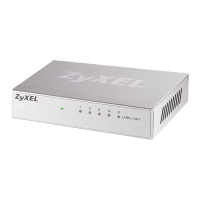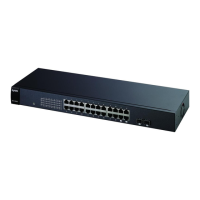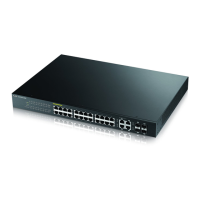Do you have a question about the ZyXEL Communications GS 2200 and is the answer not in the manual?
Lists methods to manage the Switch: Web Configurator, CLI, FTP, SNMP, Cluster Management.
Details the console port parameters and connection for local management.
Explains auto-negotiation, auto-crossover, and dual personality interfaces.
Describes mini-GBIC slots for transceivers and their installation.
Step-by-step guide to accessing the web configurator and logging in.
Describes the navigating components of a web configurator screen.
Recommends changing the default administrator password upon first login.
Explains how to save settings to run-time and nonvolatile memory.
Details how to reload the factory-default configuration file.
Explains how to confine broadcast frames to a VLAN group.
Describes using PVID to tag incoming untagged frames for VLAN forwarding.
Details configuring the Switch IP address and subnet mask.
Tutorial on configuring DHCP snooping on the Switch.
Tutorial on configuring the Switch to forward DHCP client requests.
Steps to enable DHCP relay and add relay agent information.
Displays port statistics and describes table labels.
Shows detailed performance data for an individual port.
Displays system name, product model, firmware version, and hardware monitor details.
Configures general settings like system name and time.
Configures VLAN Type, ARP Aging Time, and GARP Timers.
Configures Switch IP, default gateway, DNS, and management VLAN ID.
Details configuring IP addresses for Switch management over the network.
Configures Switch port settings like speed, duplex, flow control, and priority.
Displays current power status for PDs and PoE status screens.
Sets priority levels for distributing power to PDs.
Displays all VLAN groups and allows searching by VLAN ID.
Views detailed port settings and status of VLAN groups.
Configures and views 802.1Q VLAN parameters for the Switch.
Configures static VLAN settings on a port.
Groups traffic into VLANs based on source IP subnet.
Configures subnet-based VLANs with priority and VID.
Groups traffic into VLANs based on specified protocols.
Configures protocol-based VLANs with priority and port settings.
Sets up VLANs based on destination MAC address and associated port.
Configures port-based VLAN setup, including port isolation.
Manually enters static MAC addresses in the MAC address table.
Sets up rules to forward specific multicast frames to specific ports.
Creates rules for traffic filtering based on MAC addresses and VLANs.
Displays STP status based on chosen standard.
Activates one of the STP modes on the Switch.
Configures RSTP settings.
Displays the RSTP status screen.
Configures MRSTP settings.
Displays the MRSTP status screen.
Configures MSTP settings.
Configures MSTP ports.
Displays the MSTP status screen.
Configures ingress and egress rate limits for traffic flows on ports.
Configures limits for broadcast, multicast, and DLF packets per second.
Selects a monitor port and specifies traffic flow to be copied to it.
Displays configured trunk groups and their status.
Configures static link aggregation.
Enables Link Aggregation Control Protocol (LACP).
Activates port authentication and configures RADIUS server settings.
Activates IEEE 802.1x security and its port configurations.
Enables and assigns a guest VLAN to a port for unauthenticated users.
Enables port security and disables MAC address learning.
Defines classifiers and specifies actions (policy) on matching traffic.
Requires prior classifier configuration to define actions on traffic flows.
Sets priorities for Switch queues to distribute bandwidth.
Displays multicast group information.
Configures IGMP snooping, filtering, and multicast frame handling.
Configures VLANs for IGMP snooping and option 82 information.
Specifies ranges of multicast groups clients can join.
Creates multicast VLANs and selects receiver/source ports.
Configures RADIUS server settings for authentication and accounting.
Configures TACACS+ server settings for authentication and accounting.
Manages static bindings for DHCP snooping and ARP inspection.
Enables DHCP snooping, specifies DHCP server VLAN, and configures database.
Enables ARP inspection and configures log settings.
Specifies trusted/untrusted ports and ARP packet rate limits.
Configures loop guard settings on the Switch.
Configures layer 2 protocol tunneling settings on the Switch.
Limits control packet rates on ports to protect CPU efficiency.
Detects control packet rate limits and configures actions when exceeded.
Configures automatic undo of actions after an error condition resolves.
Creates static routes by specifying destination IP, subnet mask, and gateway.
Activates DiffServ for marking rules or 802.1p priority mapping.
Configures DSCP to 802.1p mapping for traffic prioritization.
Changes the DSCP-IEEE 802.1p mapping.
Enables and configures global DHCP relay.
Configures DHCP settings based on the VLAN domain of DHCP clients.
Configures ARP learning mode on a per-port basis.
Resets the Switch to factory defaults.
Saves current configuration settings to Configuration 1 or 2.
Restarts the Switch and loads configuration one or two.
Uploads the latest firmware to the Switch.
Restores a previously saved configuration file from a computer.
Saves and stores current device settings as configuration files.
Configures SNMP settings, including version and community values.
Assigns users who can access the Switch via web configurator.
Checks system logs, pings IP addresses, or performs port tests.
Configures the device's system logging settings.
Configures a list of external syslog servers.
Configures clustering management settings.
Copies basic and advanced settings from a source port to destination ports.
Provides solutions for forgotten IP addresses and login credentials.
Addresses issues related to losing configuration settings after a restart.
| Brand | ZyXEL Communications |
|---|---|
| Model | GS 2200 |
| Category | Switch |
| Language | English |











